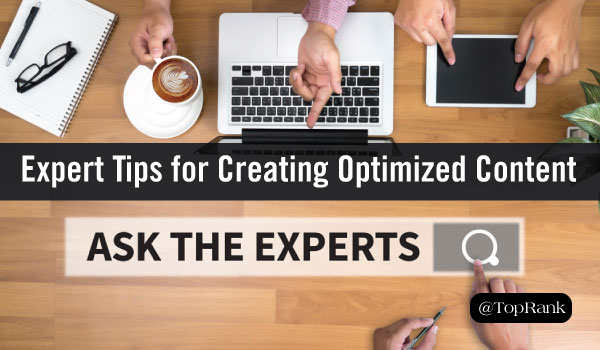
As a member of TopRank Marketing’s (epic) content team, it’s certainly no surprise that I spend much of my day developing and executing content strategies for the wide array of client programs I work on.
And as I settle in for a content extravaganza each day, my work is guided by an important agency principle: Create content that allows our clients to be the best answer for their audience.
Lucky for me—and perhaps unlucky for them—my work station is strategically placed within staring and shouting distance of every one of our SEO experts. As seasoned marketers know, quality and strategic SEO is absolutely key to crafting content that helps you satisfy your audience’s quest for answers. So, I’m often picking the brains of my neighbors to help me create content that will get results.
Today, I summoned insights from three members of our SEO team to share with you. Below you’ll find some helpful tips and insights for better leveraging SEO within your content planning and creation efforts.
What does the “perfect balance” between SEO and user experience look like?
User experience should have the “perfect balance” of SEO without anyone realizing that it’s been optimized already. The SEO aspect of content or user experience should be baked into the process early so that the optimization is as natural as possible.
The Takeaway: Make SEO an intricate part of your content planning and creation process, rather than an afterthought.
Kevin Cotch, SEO Analyst
How can marketers leverage existing content to take advantage of SEO opportunities?
I have two favorite ways to use existing content to take advantage of SEO opportunities. The first one is to look for evergreen content that doesn’t really move KPIs. For example, I love to find a blog post that drives thousands of visits and doesn’t really drive many leads. Chances are that post does a great job answering a searcher’s question and that’s why it is receiving loads of organic traffic. I like to try and figure out what question the searcher will ask next. Once you’ve figured that out you can add a call to action that offers an opt in to an email campaign or offer the visitor a downloadable asset.
You can also leverage existing content by identifying what Google doesn’t like. Many companies have multiple blog posts about ancient holiday parties, volunteer events, etc. Google will spend time and resources adding that content to their index and then never let it see the light of day. I like to look for pages and posts that are indexable and don’t receive organic traffic. Then I do one of two things. I either tell Google to ignore it or I try to improve the content so it is of value to searchers.
The Takeaway: Your work doesn’t end when your content is published. Take the time to analyze how your content is performing, and take advantage of opportunities to make it better for the user and search engines.
Steve Slater, Digital Advertising & SEO Manager
What are some key characteristics of “good” SEO content?
Overall, I think that the most important factors that make a piece of content good for SEO (i.e. robots) are the same as those that make content good for users (i.e. humans).
The best content:
- Is targeted towards a specific niche
- Is built upon an understanding of which questions and pain points are relevant to said niche
- Delivers value to readers by answering questions or helping to address pain points
The Takeaway: When you understand what your audience is searching for you can create amazing content that delivers value to people and search engines.
Evan Prokop, Senior Analytics Manager
Bonus: What’s one of the quickest ways to evaluate a piece of content’s SEO value or opportunities?
Kevin: One of the quickest ways to evaluate a piece of content’s SEO value or opportunities would be seeing how many organic conversions it drives. Organic conversions can range from actual purchases to subscribing to an email list. Marketers should put less emphasis on keyword rankings for SEO value as there are more than just one keyword that drives people (organically) to a website or conversion.
Steve: One of the quickest ways to evaluate a piece of content’s SEO value is to look at the Organic Landing Page report in Google Analytics. This report tells you the pages that searchers land on right after they see search results. This means that the pages in this report are the pages that come up in search results. When you are looking through this report you can identify pages that drive conversions and you can also identify pages that drive searchers back to Google to look for a better answer.
Evan: Put yourself in your reader’s shoes by doing a search using a phrase that you think your content is most relevant for (i.e. should rank for) and honestly ask yourself, or a friend, if it delivers a satisfying answer to what you searched for. If it doesn’t for you, you can bet it won’t for your readers either.
Next, compare your content to what’s already ranking. Is your title at least as compelling as the competition? Are you covering the topic as well? Does the page load fast and look nice on either desktop or mobile? If the answer to any of these questions is no, there’s your opportunity.
What are your burning SEO and content questions? Ask them in the comments section below.





